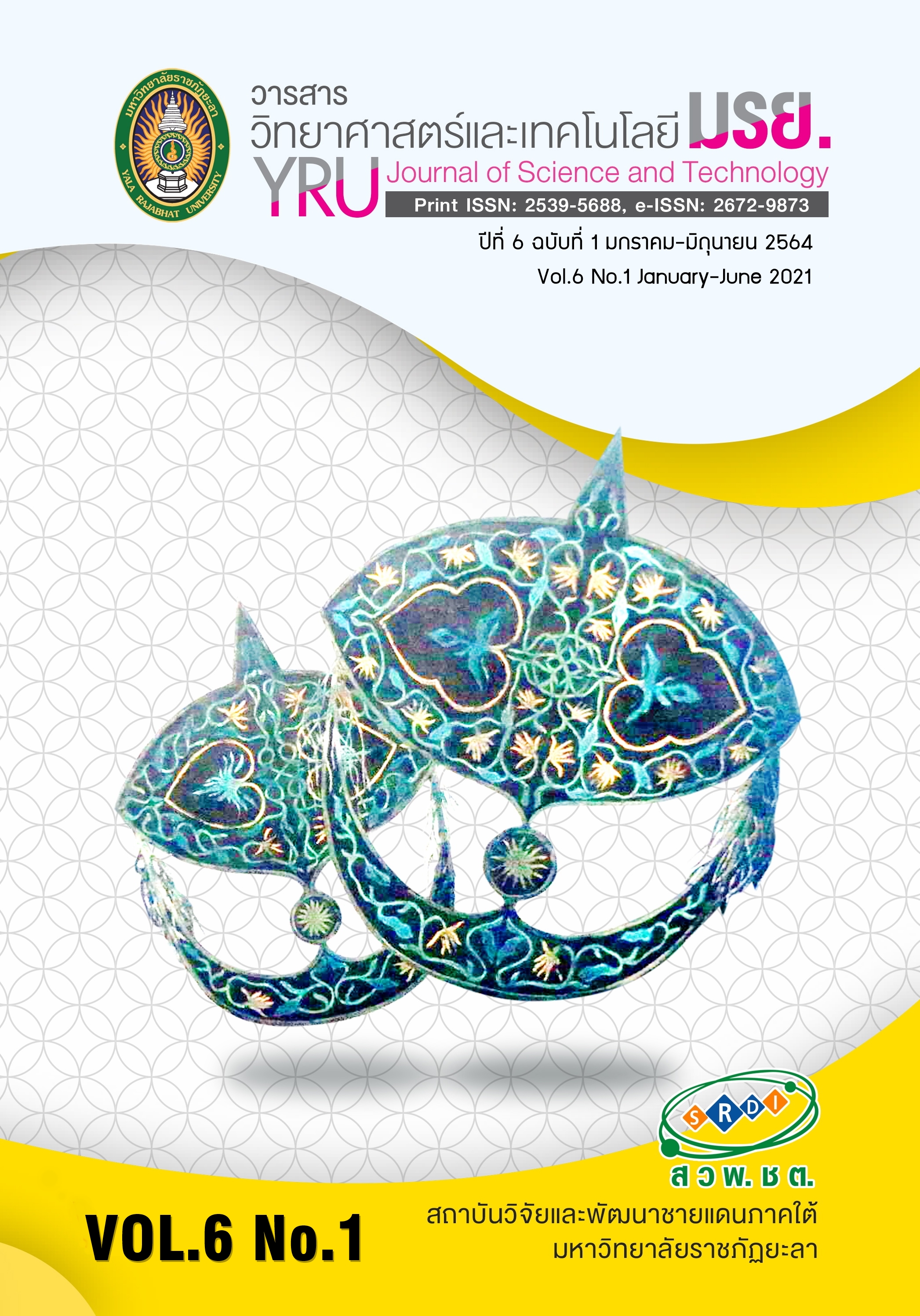การศึกษาสารประกอบฟีนอลิกในสารสกัดจากต้นโคลงเคลงด้วยเทคนิค HPTLC และฤทธิ์ต้านแบคทีเรียก่อโรคในอาหาร
Main Article Content
บทคัดย่อ
โคลงเคลงเป็นสมุนไพรพื้นบ้าน พบมากในภาคใต้ของไทย มีสรรพคุณรักษาโรคและฆ่าเชื้อ ดังนั้นจึงวิจัยเพื่อศึกษาชนิดและปริมาณสารประกอบฟีนอลิก 5 ชนิด ได้แก่ คาเทชิน กรดแกลลิก รูติน ลูทีโอลิน และเควอซิติน ในสารสกัดอะซิโตนจากพืชโคลงเคลงด้วยเทคนิค HPTLC ซึ่งเป็นเทคนิคที่ง่าย ประหยัด รวดเร็ว และเป็นมิตรต่อสิ่งแวดล้อม เนื่องจากของเสียที่เกิดขึ้นมีปริมาณน้อย โดยสกัดสารจากส่วนผล ใบ ก้าน และรากด้วยคลื่นเสียงความถี่สูง นำสารสกัดของทุกส่วนมาวิเคราะห์หาปริมาณสารประกอบฟีนอลิกทั้ง 5 ชนิด ด้วยกราฟมาตรฐานที่มีความสัมพันธ์ระหว่างพื้นที่ใต้กราฟของการดูดกลืนแสงที่ความยาวคลื่น 254 และ 366 nm กับความเข้มข้นของสารละลายมาตรฐานที่วิเคราะห์บนแผ่น (HPTLC 60F254 silica gel plate) เดียวกับสารสกัด มีความสัมพันธ์เชิงเส้นตรง (r > 0.99) ช่วงของการวิเคราะห์เท่ากับ 100 – 2000 ng/band จากการวิเคราะห์ให้ผลดังนี้ ส่วนผลพบสารสำคัญมากที่สุด คือ คาเทชิน (0.027 %), กรดแกลลิก (0.034 %), ลูทีโอลิน (0.017 %) และเควอซิติน (0.020 %) และส่วนอื่น ๆ พบสารสำคัญเพียง 2 ชนิด ปริมาณร้อยละ 0.011-0.049 นอกจากนี้ได้มีการศึกษาฤทธิ์การยับยั้งเชื้อแบคทีเรียก่อโรคในอาหาร 3 สายพันธุ์ คือ S. aureus, B. cereus และ E. coli ทดสอบด้วยวิธี Agar well diffusion พบว่าสารสกัดจากส่วนผล ก้าน และราก สามารถยับยั้งเชื้อ S. aureus ได้ ข้อค้นพบชี้ให้เห็นว่าโคลงเคลงเป็นพืชที่สามารถนำมาพัฒนาเป็นผลิตภัณฑ์เสริมอาหารเพื่อบริโภคได้
Article Details
บทความ ข้อมูล เนื้อหา รูปภาพ ฯลฯ ที่ได้รับการเผยแพร่ในวารสารวิทยาศาสตร์และเทคโนโลยี มรย. นี้ ถือเป็นลิขสิทธิ์ของวารสารวิทยาศาสตร์และเทคโนโลยี มรย. หากบุคคลหรือหน่วยงานใดต้องการนำทั้งหมดหรือส่วนหนึ่งส่วนใดไปเผยแพร่ต่อหรือกระทำการใดๆ จะต้องได้รับอนุญาตเป็นลายลักษณ์อักษรจากวารสารวิทยาศาสตร์และเทคโนโลยี มรย. ก่อนเท่านั้น
เอกสารอ้างอิง
Alnajar, Z. A. A., Abdulla, M. A., Ali, H. M., Alshawsh, M. A., & Hadi, A. H. A. (2012). Acute toxicity evaluation, antibacterial, antioxidant and immunomodulatory effects of Melastoma malabathricum. Molecules, 17(3), 3547-3559.
Awang, M. A., Aziz, R., Sarmidi, M. R., Abdullah, L., Yong, P., & Musa, N. (2016). Comparison of different solvents on the extraction of Melastoma malabathricum leaves using Soxhlet extraction method. Der Pharmacia Lettre, 8(17), 153-157.
Broszat, M., (2018), HPTLC Fundamental: Qualitative and quantitative analysis of botanical [Class handout]. Muttenz, SWITZERLAND: CAMAG.
Giri, D. & Rajbhandari, M. (2018). Phytochemical analysis and constituents of hexane extract of Melastoma malabathricum L. Journal of Institute of Science and Technology, 23(1), pp. 18-25. doi: 10.3126/jist.v23i1.22150.
Hussain, S. Z., Maqbool, K., & Naseer, B. (2019). High performance thin layer chromatography: Principle, working and applications. International Journal of Research in Pharmacy and Pharmaceutical Sciences, 4(3), 83-88.
Jaiswal, Y., Tatke, P., Gabhe, S., & Vaidya, A. (2013). Rapid high performance thin layer chromatographic method for quantitation of catechin from extracts of cashew leaves–a short report. Polish Journal of Food and Nutrition Sciences, 63(1), 49-53.
Joffry, S. M., Yob, N. J., Rofiee, M. S., Affandi, M. M. R., Suhaili, Z., Othman, F., et al. (2012). Melastoma malabathricum (L.) Smith ethnomedicinal uses, chemical constituents, and pharmacological properties: a review. Evidence-Based Complementary and Alternative Medicine, 2012:258434, 1-48. doi: 10.1155/2012/258434
Kumar, V., Ahmed, D., Gupta, P. S., Anwar, F., & Mujeeb, M. (2013). Anti-diabetic, anti-oxidant and anti-hyperlipidemic activities of Melastoma malabathricum Linn. leaves in streptozotocin induced diabetic rats. BMC Complementary and Alternative Medicine, 13(1), 1-19.
Miklasinska, M., Kepa, M., Wojtyczka, R. D., Idzik, D., Dziedzic, A., & Wasik, T. J. (2016). Catechin hydrate augments the antibacterial action of selected antibiotics against Staphylococcus aureus clinical strains. Molecules, 21(2), 244.
Nile, S. H., & Park, S. W. (2014). HPTLC densitometry method for simultaneous determination of flavonoids in selected medicinal plants. Frontiers in Life Science, 8(1), 97-103. doi: 10.1080/21553769.2014.969387
Varghese, S.,Narmadha, R., Gomathi, D., Kalaiselvi, M., & Devaki, K. (2013). Phytochemical screening and HPTLC finger printing analysis of Citrullus lanatus (Thunb.) seed. Journal of Acute Disease, 2(2), 122-126.
Yadav, M., Chatterji, S., Gupta, S. K., & Watal, G. (2014). Preliminary phytochemical screening of six medicinal plants used in traditional medicine. International Journal of Pharmacy and Pharmaceutical Sciences, 6(5), 539-542.
Zakaria, Z. A., Rofiee, M. S., Mohamed, A. M., Teh, L. K., & Salleh, M. Z. (2011). In vitro antiproliferative and antioxidant activities and total phenolic contents of the extracts of Melastoma malabathricum leaves. Journal of Acupuncture and Meridian Studies, 4(4), 248-256.


